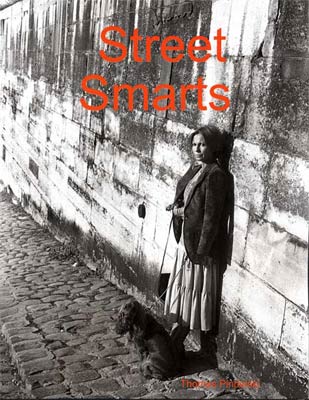What do you do with all those old pictures, stuffed in boxes, lost to posterity?
Get off your duff and publish a book!
Too expensive, you say? Not with print-on-demand technology, available from the likes of Lulu. You submit your book in PDF format and what you see is what you get, whether you opt for black and white or the pricier color. A great way to memorialize family albums, your best pictures, the growth of a child. And friends love to get books as presents, especially as nothing could be more personal than your own book of photographs.
Here is the preface to my book Street Smarts, published in April, 2005:

The Swinging Sixties were over.
David Bailey was passé.
A Nikon was the required passport to photographic respectability. The pound in your pocket, the Prime Minister reminded us, had not been devalued. Princess Di and her coterie of press manipulators were nowhere in sight and the Third Estate still preferred discretion to disclosure.
That ne plus ultra of genteel camera stores, Wallace Heaton on New BondStreet, was still very much in business, replete with Royal warrants and walnut paneling. Later it was to suffer the ignominy of acquisition by amass merchandiser only to be bowdlerized into oblivion.
With my earliest visual recollections being of Degas, Sisley and Manet and their photographic successors, Cartier Bresson, Brassai and Kertesz, I wanted nothing so much in the whole world as to take street pictures. In1971 I was at college, aged 19, with my net worth invested in an already dated Leica camera with but one lens. Obsolete or not, it remains the best street photography machine yet devised.
Realizing that fewer variables made for less risk in the photographic process, I settled on Kodak TriX film processed at home in Kodak’s venerable D76 developer. The meat and potatoes of any self-respecting street photographer’s diet. Printing required that a piece of hardboard be attached to my bedroom window with three trays of smelly chemicals and an old Gamer enlarger. Plus a red bulb so as not to trip on our Scottish Terrier.
Why street photographs? It always seemed to me that the genre offered too much that was either humorless or contrived. Posed pictures trying to pass for spontaneity. Worst of all, much of the work out there was positively invasive when it came to respecting other’s privacy. Cameras cruelly stuck in the faces of the poor or destitute. Not for me. But make it spontaneous and interject a touch of humor and now you have a picture worth taking.
Life at University College, London was blissfully easy. Attendance was not monitored and class content was not especially challenging. Most of the professors preferred to work on their richly subsidized governmental contracts, caring little for their teaching. A degree could be earned by having fun for two years and nine months and then working like stink forthe final three. So fun it was.
London’s great spaces beckoned. The Courtauld Institute was across the road. The British Museum around the corner. UC’s magnificent library a few yards away. Then there were the great Victorian parks. Hyde Park, Kensington Gardens, Holland Park, Regents Park, Green Park, St. James’s Park – all a short, free, Tube ride away.
It took but a couple of rolls of film to learn that stealth and speed were the norm for the Leica, a near silent piece of engineering genius. Subjects were everywhere. Lenses were cheap. The small collapsible 50mm Elmar lens, which came with my M3, was soon supplemented with a long focus 90mm Elmar, costing all of $60 and a 35mm Summaron wide angle for $75. Thank God for scholarships….
It was the wide angle Summaron that was most frequently mounted on my Leica. You had to get close to your subject to fill the frame. “If your pictures are not good enough, you are not close enoughâ€, Robert Capa had said. And when the opportunity finally arose to visit Paris, but one camera and lens came along – the Leica M3 with the 35mm Summaron. And six rolls of TriX film. No one had taught me that you had to take thousands of pictures to get a good one and some two rolls remained unused after a week in the world’s most beautiful city.
In the 1970s the British photographic press was mercifully more interested in pictures than in equipment. It was a fine outlet for publishing one’s photographs, and you even got paid, which is a good thing on a student’s income. Further, the occasional prize went a long way to providing film, paper and chemicals to keep the productive process going. Another great resource was the extensive photographic library at the Royal Photographic Society, which made its home in Mayfair at South Audley Street, offering a student membership for a negligible sum. It was a rare afternoon that would not find me in its warm interior, poring over the works of the Old World masters while also learning that there was a whole New World to be found across the Atlantic, in the guise of the works of Edward Weston, Imogen Cunningham and Walker Evans. Pictures and vistas we could simply not imagine in England’s subtler landscape. Then there was the public library on Hornton Street in Kensington with hundreds of books on art and photography. All free.
So there you have it. An easy life, no money, free resources and the beststreet photography opportunities life could offer. By 1977, now trying to earn a living and increasingly coming into contact with the New World, with all its energy and innovation, it was clear that the path to success lay elsewhere. While flying on a one-way ticket to the west coast of the United States in November 1977, it dawned on me that no one could take away all those warm memories which you see illustrated here.
You can buy the book by clicking here.